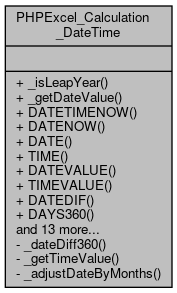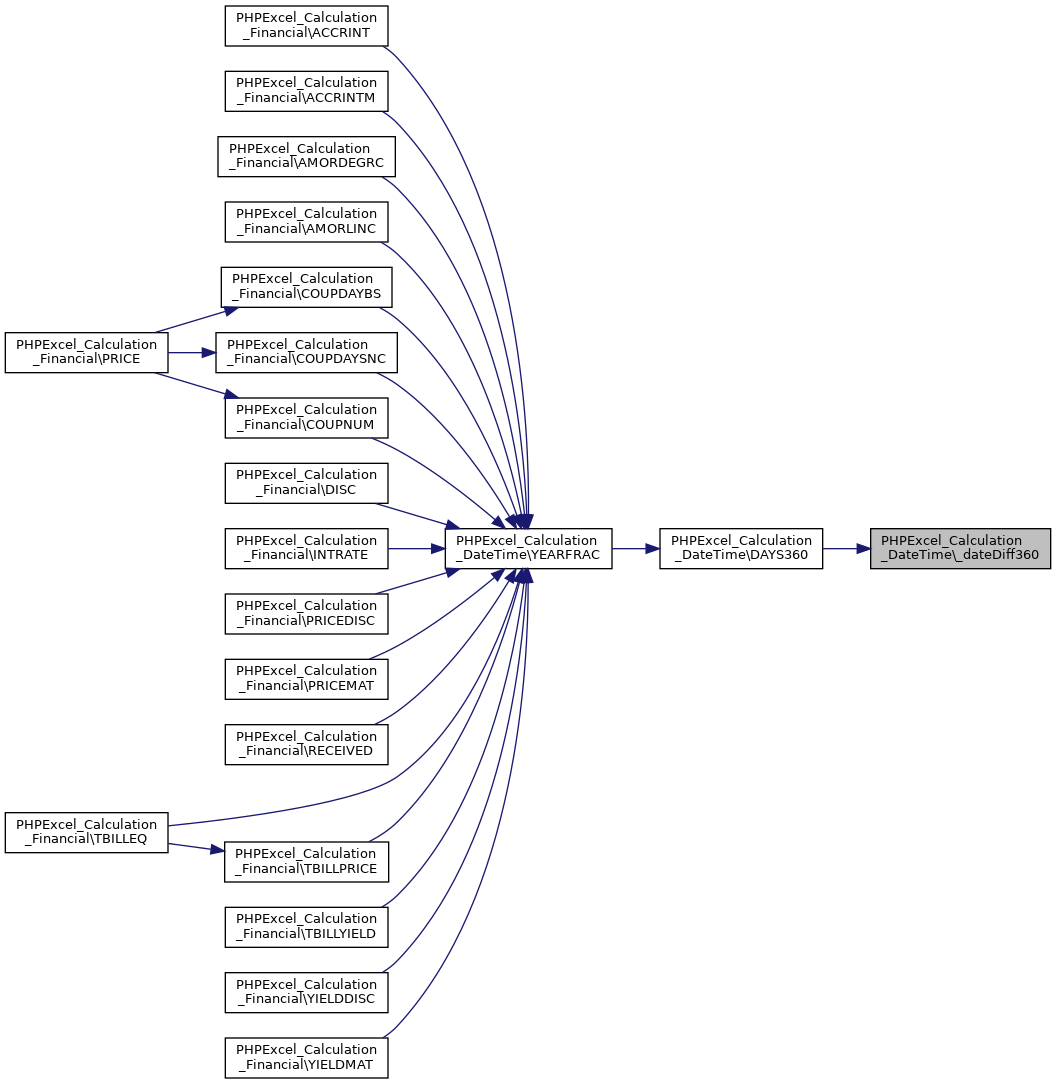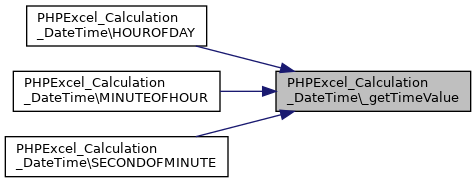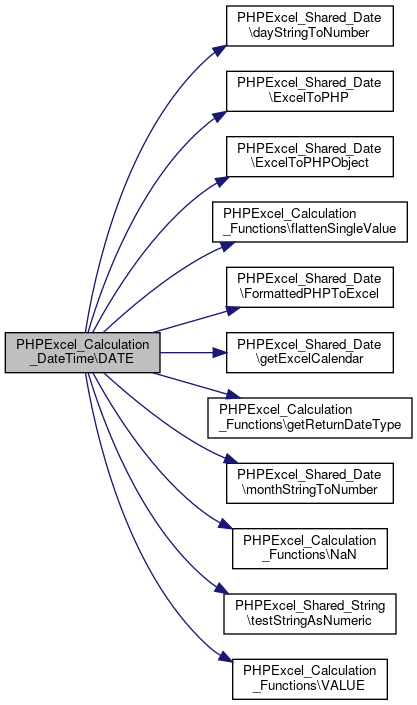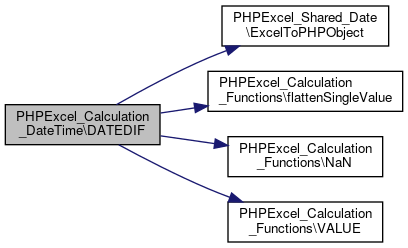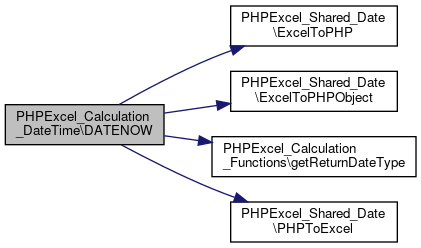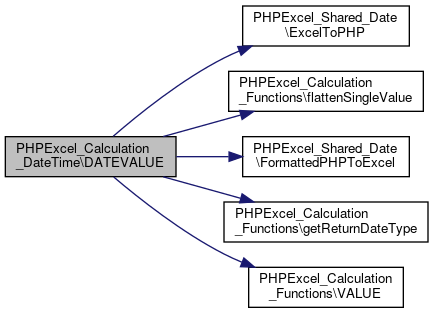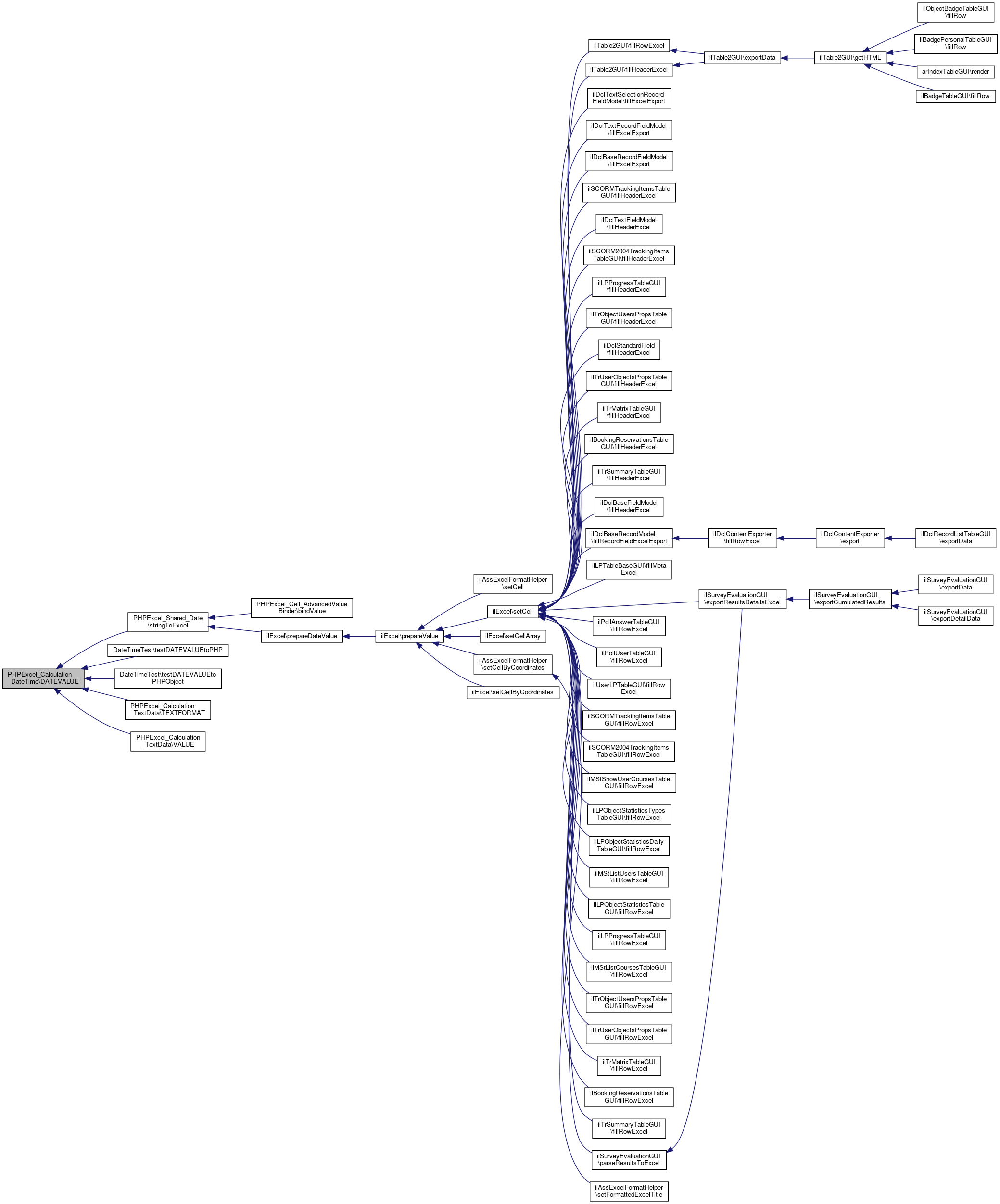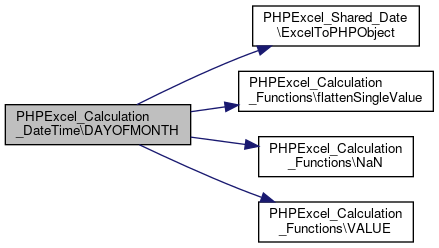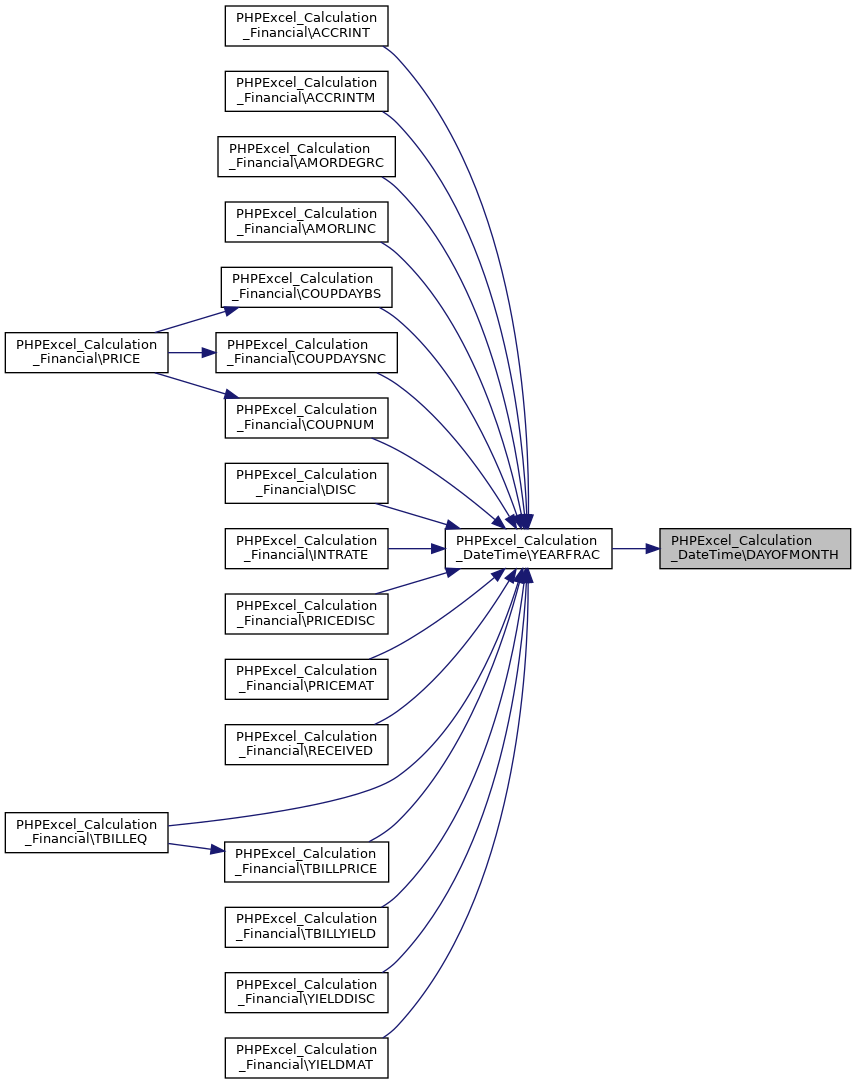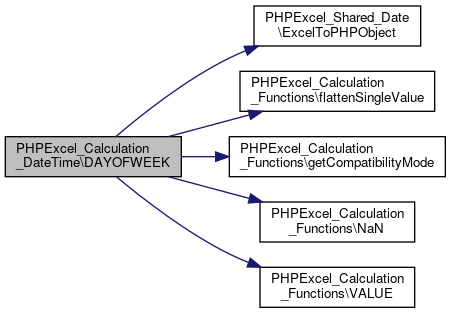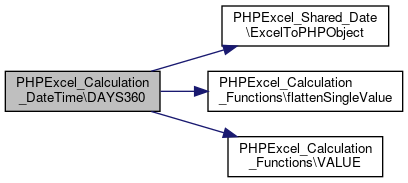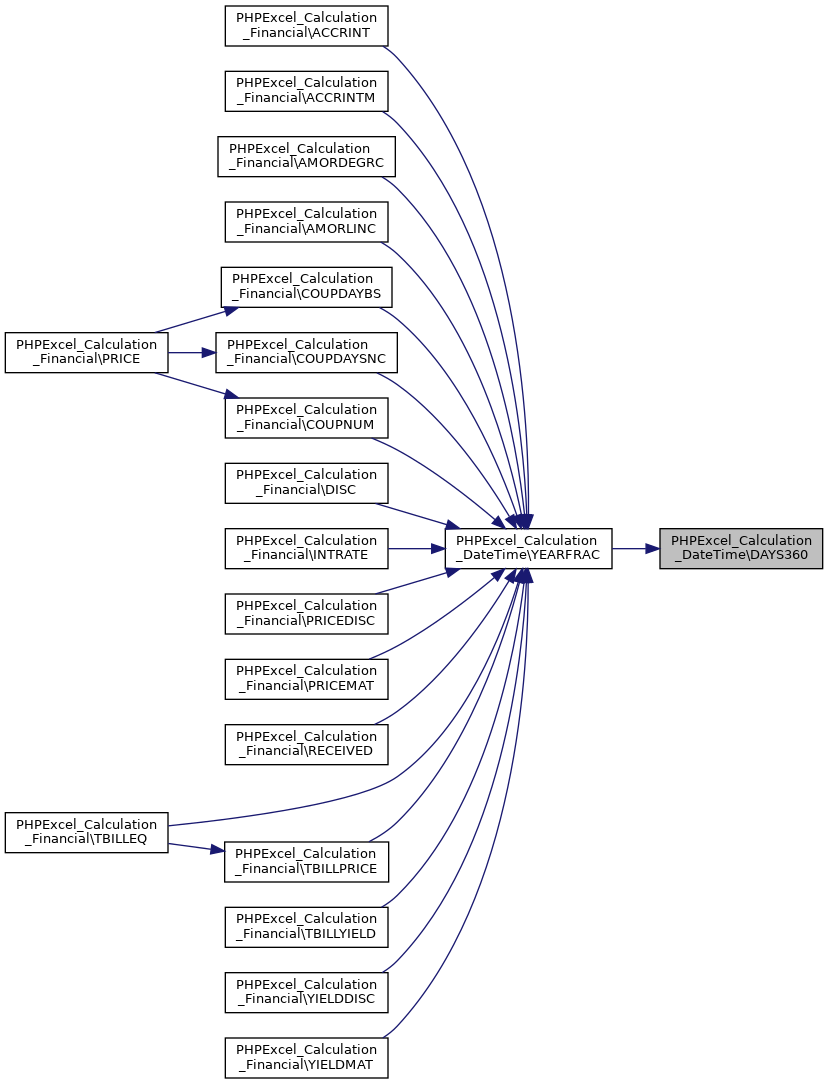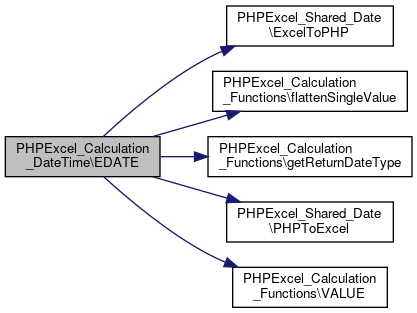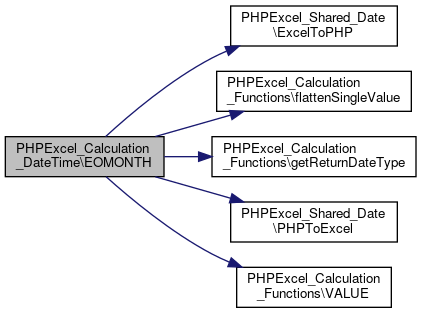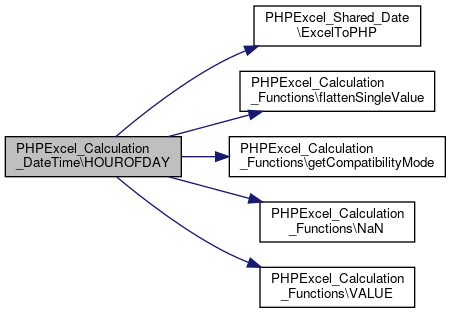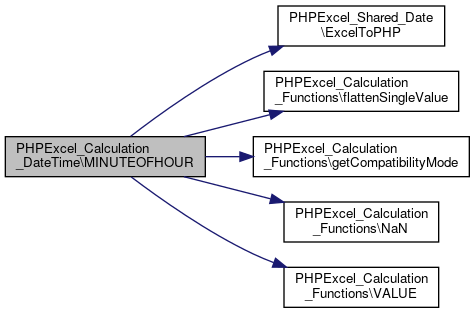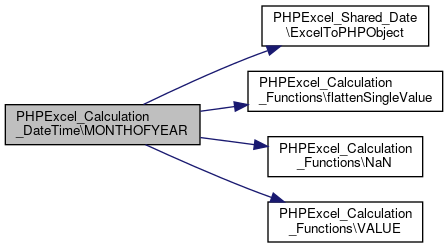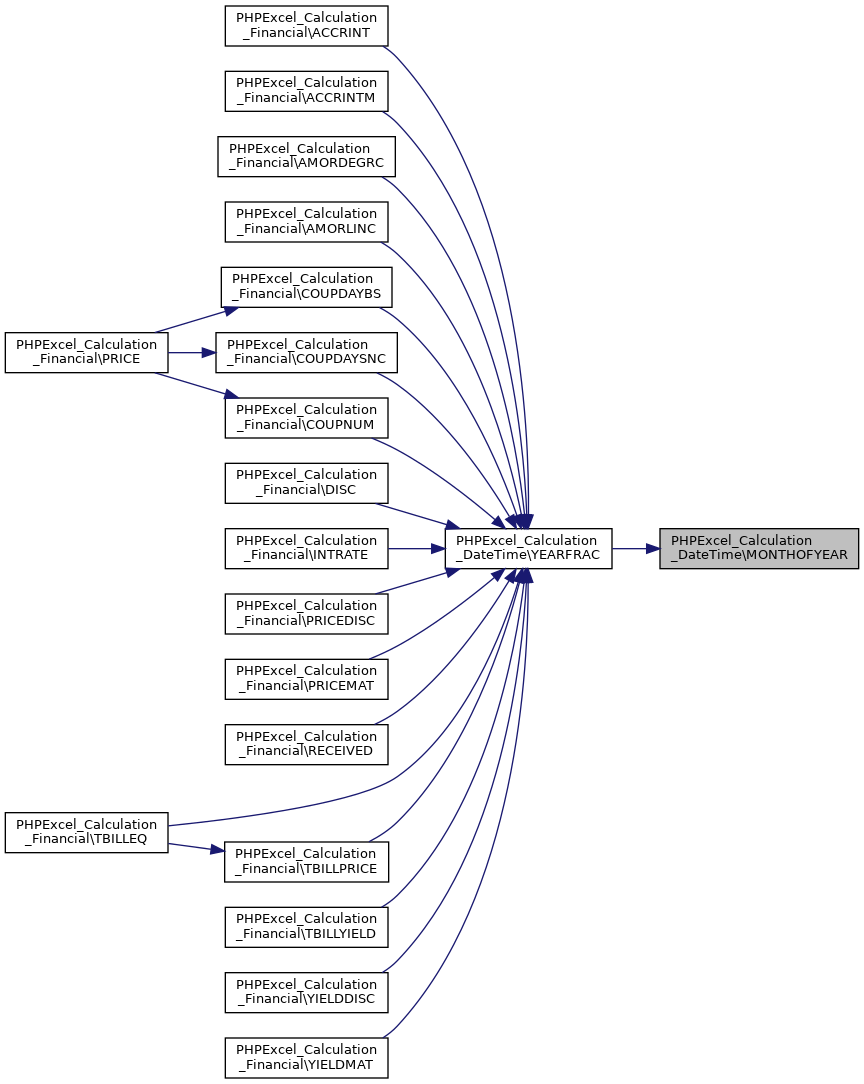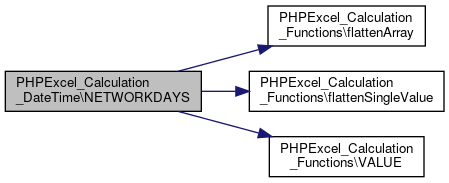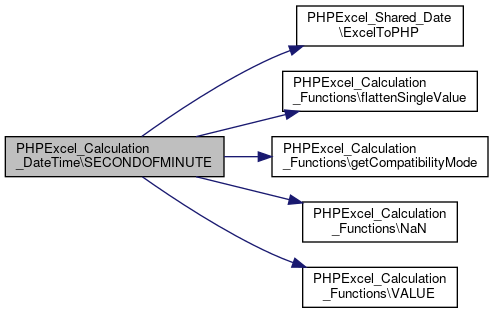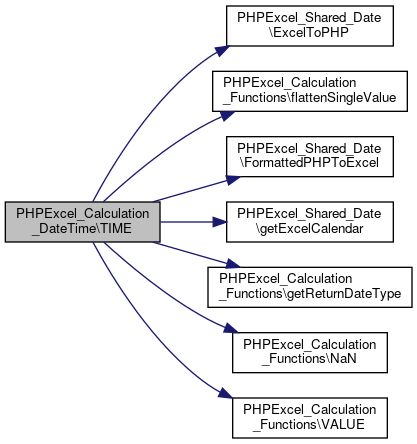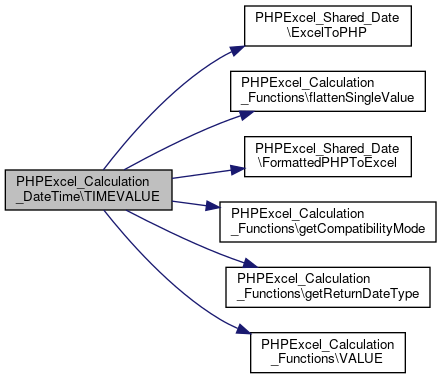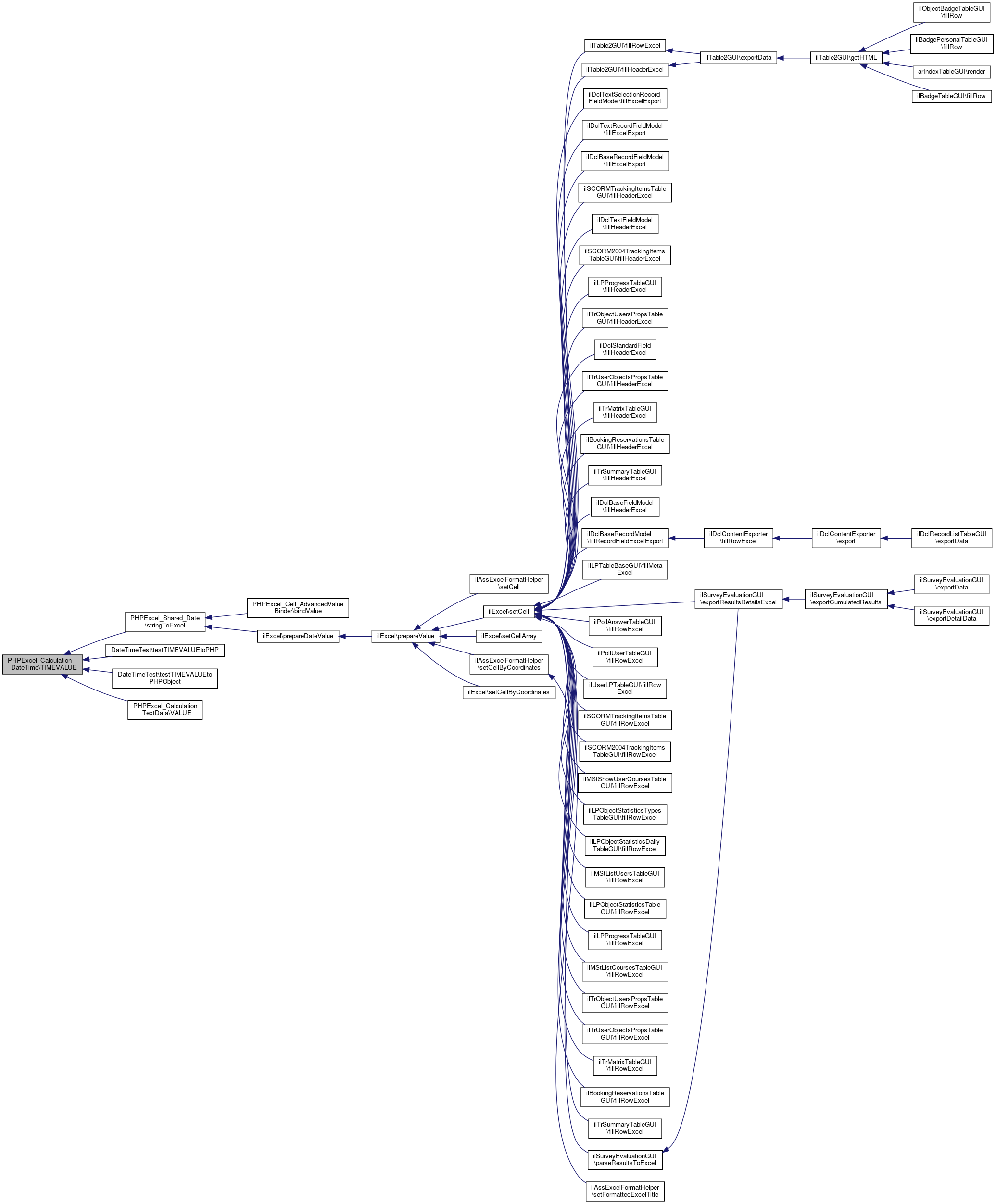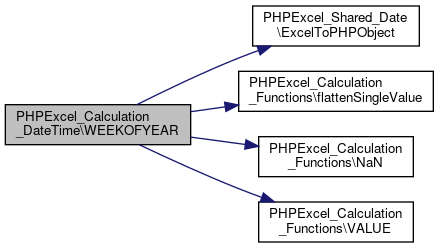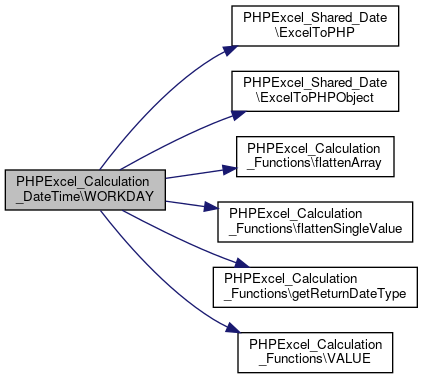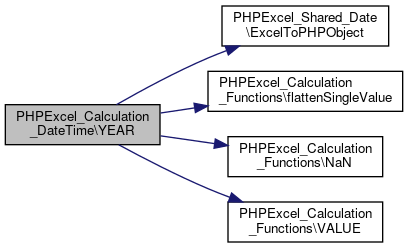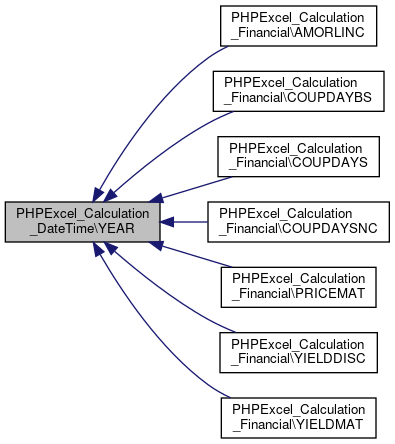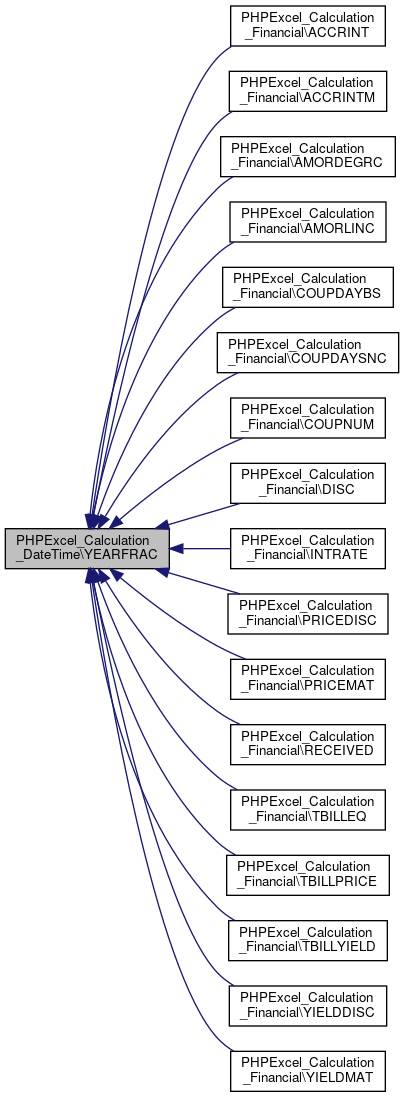 Collaboration diagram for PHPExcel_Calculation_DateTime:
Collaboration diagram for PHPExcel_Calculation_DateTime:Static Public Member Functions | |
| static | _isLeapYear ($year) |
| Identify if a year is a leap year or not. More... | |
| static | _getDateValue ($dateValue) |
| _getDateValue More... | |
| static | DATETIMENOW () |
| static | DATENOW () |
| static | DATE ($year=0, $month=1, $day=1) |
| static | TIME ($hour=0, $minute=0, $second=0) |
| static | DATEVALUE ($dateValue=1) |
| static | TIMEVALUE ($timeValue) |
| static | DATEDIF ($startDate=0, $endDate=0, $unit='D') |
| DATEDIF. More... | |
| static | DAYS360 ($startDate=0, $endDate=0, $method=false) |
| static | YEARFRAC ($startDate=0, $endDate=0, $method=0) |
| static | NETWORKDAYS ($startDate, $endDate) |
| static | WORKDAY ($startDate, $endDays) |
| static | DAYOFMONTH ($dateValue=1) |
| DAYOFMONTH. More... | |
| static | DAYOFWEEK ($dateValue=1, $style=1) |
| DAYOFWEEK. More... | |
| static | WEEKOFYEAR ($dateValue=1, $method=1) |
| WEEKOFYEAR. More... | |
| static | MONTHOFYEAR ($dateValue=1) |
| MONTHOFYEAR. More... | |
| static | YEAR ($dateValue=1) |
| YEAR. More... | |
| static | HOUROFDAY ($timeValue=0) |
| HOUROFDAY. More... | |
| static | MINUTEOFHOUR ($timeValue=0) |
| MINUTEOFHOUR. More... | |
| static | SECONDOFMINUTE ($timeValue=0) |
| SECONDOFMINUTE. More... | |
| static | EDATE ($dateValue=1, $adjustmentMonths=0) |
| EDATE. More... | |
| static | EOMONTH ($dateValue=1, $adjustmentMonths=0) |
| EOMONTH. More... | |
Static Private Member Functions | |
| static | _dateDiff360 ($startDay, $startMonth, $startYear, $endDay, $endMonth, $endYear, $methodUS) |
| Return the number of days between two dates based on a 360 day calendar. More... | |
| static | _getTimeValue ($timeValue) |
| _getTimeValue More... | |
| static | _adjustDateByMonths ($dateValue=0, $adjustmentMonths=0) |
Detailed Description
Definition at line 46 of file DateTime.php.
Member Function Documentation
◆ _adjustDateByMonths()
|
staticprivate |
Definition at line 135 of file DateTime.php.
References PHPExcel_Shared_Date\ExcelToPHPObject().
Referenced by EDATE(), and EOMONTH().
 Here is the call graph for this function:
Here is the call graph for this function: Here is the caller graph for this function:
Here is the caller graph for this function:◆ _dateDiff360()
|
staticprivate |
Return the number of days between two dates based on a 360 day calendar.
- Parameters
-
integer $startDay Day of month of the start date integer $startMonth Month of the start date integer $startYear Year of the start date integer $endDay Day of month of the start date integer $endMonth Month of the start date integer $endYear Year of the start date boolean $methodUS Whether to use the US method or the European method of calculation
- Returns
- integer Number of days between the start date and the end date
Definition at line 71 of file DateTime.php.
References $endYear, and $startYear.
Referenced by DAYS360().
 Here is the caller graph for this function:
Here is the caller graph for this function:◆ _getDateValue()
|
static |
_getDateValue
- Parameters
-
string $dateValue
- Returns
- mixed Excel date/time serial value, or string if error
Definition at line 101 of file DateTime.php.
References PHPExcel_Calculation_Functions\COMPATIBILITY_GNUMERIC, DATEVALUE(), PHPExcel_Calculation_Functions\getCompatibilityMode(), PHPExcel_Calculation_Functions\getReturnDateType(), PHPExcel_Shared_Date\PHPToExcel(), PHPExcel_Calculation_Functions\RETURNDATE_EXCEL, PHPExcel_Calculation_Functions\setReturnDateType(), and PHPExcel_Calculation_Functions\VALUE().
Referenced by PHPExcel_Calculation_Financial\COUPDAYBS(), PHPExcel_Calculation_Financial\COUPDAYS(), PHPExcel_Calculation_Financial\COUPDAYSNC(), PHPExcel_Calculation_Financial\COUPNCD(), PHPExcel_Calculation_Financial\COUPNUM(), PHPExcel_Calculation_Financial\COUPPCD(), PHPExcel_Calculation_Financial\PRICE(), PHPExcel_Calculation_Financial\TBILLEQ(), PHPExcel_Calculation_Financial\TBILLPRICE(), and PHPExcel_Calculation_Financial\TBILLYIELD().
 Here is the call graph for this function:
Here is the call graph for this function: Here is the caller graph for this function:
Here is the caller graph for this function:◆ _getTimeValue()
|
staticprivate |
_getTimeValue
- Parameters
-
string $timeValue
- Returns
- mixed Excel date/time serial value, or string if error
Definition at line 126 of file DateTime.php.
References PHPExcel_Calculation_Functions\getReturnDateType(), PHPExcel_Calculation_Functions\RETURNDATE_EXCEL, PHPExcel_Calculation_Functions\setReturnDateType(), and TIMEVALUE().
Referenced by HOUROFDAY(), MINUTEOFHOUR(), and SECONDOFMINUTE().
 Here is the call graph for this function:
Here is the call graph for this function: Here is the caller graph for this function:
Here is the caller graph for this function:◆ _isLeapYear()
|
static |
Identify if a year is a leap year or not.
- Parameters
-
integer $year The year to test
- Returns
- boolean TRUE if the year is a leap year, otherwise FALSE
Definition at line 54 of file DateTime.php.
Referenced by PHPExcel_Calculation_Financial\_daysPerYear(), PHPExcel_Calculation_Financial\AMORLINC(), and YEARFRAC().
 Here is the caller graph for this function:
Here is the caller graph for this function:◆ DATE()
|
static |
Definition at line 292 of file DateTime.php.
References PHPExcel_Shared_Date\dayStringToNumber(), PHPExcel_Shared_Date\ExcelToPHP(), PHPExcel_Shared_Date\ExcelToPHPObject(), PHPExcel_Calculation_Functions\flattenSingleValue(), PHPExcel_Shared_Date\FormattedPHPToExcel(), PHPExcel_Shared_Date\getExcelCalendar(), PHPExcel_Calculation_Functions\getReturnDateType(), PHPExcel_Shared_Date\monthStringToNumber(), PHPExcel_Calculation_Functions\NaN(), PHPExcel_Calculation_Functions\RETURNDATE_EXCEL, PHPExcel_Calculation_Functions\RETURNDATE_PHP_NUMERIC, PHPExcel_Calculation_Functions\RETURNDATE_PHP_OBJECT, PHPExcel_Shared_String\testStringAsNumeric(), and PHPExcel_Calculation_Functions\VALUE().
Referenced by DateTimeTest\testDATEtoPHP(), DateTimeTest\testDATEtoPHPObject(), DateTimeTest\testDATEwith1904Calendar(), and DateTimeTest\testDATEwith1904CalendarError().
 Here is the call graph for this function:
Here is the call graph for this function: Here is the caller graph for this function:
Here is the caller graph for this function:◆ DATEDIF()
|
static |
DATEDIF.
- Parameters
-
mixed $startDate Excel date serial value, PHP date/time stamp, PHP DateTime object or a standard date string mixed $endDate Excel date serial value, PHP date/time stamp, PHP DateTime object or a standard date string string $unit
- Returns
- integer Interval between the dates
Definition at line 618 of file DateTime.php.
References PHPExcel_Shared_Date\ExcelToPHPObject(), PHPExcel_Calculation_Functions\flattenSingleValue(), PHPExcel_Calculation_Functions\NaN(), and PHPExcel_Calculation_Functions\VALUE().
Referenced by PHPExcel_Calculation_Financial\XNPV(), and YEARFRAC().
 Here is the call graph for this function:
Here is the call graph for this function: Here is the caller graph for this function:
Here is the caller graph for this function:◆ DATENOW()
|
static |
Definition at line 220 of file DateTime.php.
References PHPExcel_Shared_Date\ExcelToPHP(), PHPExcel_Shared_Date\ExcelToPHPObject(), PHPExcel_Calculation_Functions\getReturnDateType(), PHPExcel_Shared_Date\PHPToExcel(), PHPExcel_Calculation_Functions\RETURNDATE_EXCEL, PHPExcel_Calculation_Functions\RETURNDATE_PHP_NUMERIC, and PHPExcel_Calculation_Functions\RETURNDATE_PHP_OBJECT.
Referenced by PHPExcel_Worksheet_AutoFilter\_dynamicFilterDateRange().
 Here is the call graph for this function:
Here is the call graph for this function: Here is the caller graph for this function:
Here is the caller graph for this function:◆ DATETIMENOW()
|
static |
Definition at line 180 of file DateTime.php.
References PHPExcel_Calculation_Functions\getReturnDateType(), PHPExcel_Shared_Date\PHPToExcel(), PHPExcel_Calculation_Functions\RETURNDATE_EXCEL, PHPExcel_Calculation_Functions\RETURNDATE_PHP_NUMERIC, and PHPExcel_Calculation_Functions\RETURNDATE_PHP_OBJECT.
 Here is the call graph for this function:
Here is the call graph for this function:◆ DATEVALUE()
|
static |
Definition at line 481 of file DateTime.php.
References $t, date, PHPExcel_Shared_Date\ExcelToPHP(), PHPExcel_Calculation_Functions\flattenSingleValue(), PHPExcel_Shared_Date\FormattedPHPToExcel(), PHPExcel_Calculation_Functions\getReturnDateType(), PHPExcel_Calculation_Functions\RETURNDATE_EXCEL, PHPExcel_Calculation_Functions\RETURNDATE_PHP_NUMERIC, PHPExcel_Calculation_Functions\RETURNDATE_PHP_OBJECT, and PHPExcel_Calculation_Functions\VALUE().
Referenced by _getDateValue(), PHPExcel_Shared_Date\stringToExcel(), DateTimeTest\testDATEVALUEtoPHP(), DateTimeTest\testDATEVALUEtoPHPObject(), PHPExcel_Calculation_TextData\TEXTFORMAT(), and PHPExcel_Calculation_TextData\VALUE().
 Here is the call graph for this function:
Here is the call graph for this function: Here is the caller graph for this function:
Here is the caller graph for this function:◆ DAYOFMONTH()
|
static |
DAYOFMONTH.
Returns the day of the month, for a specified date. The day is given as an integer ranging from 1 to 31.
Excel Function: DAY(dateValue)
- Parameters
-
mixed $dateValue Excel date serial value (float), PHP date timestamp (integer), PHP DateTime object, or a standard date string
- Returns
- int Day of the month
Definition at line 1071 of file DateTime.php.
References PHPExcel_Shared_Date\ExcelToPHPObject(), PHPExcel_Calculation_Functions\flattenSingleValue(), PHPExcel_Calculation_Functions\NaN(), and PHPExcel_Calculation_Functions\VALUE().
Referenced by YEARFRAC().
 Here is the call graph for this function:
Here is the call graph for this function: Here is the caller graph for this function:
Here is the caller graph for this function:◆ DAYOFWEEK()
|
static |
DAYOFWEEK.
Returns the day of the week for a specified date. The day is given as an integer ranging from 0 to 7 (dependent on the requested style).
Excel Function: WEEKDAY(dateValue[,style])
- Parameters
-
mixed $dateValue Excel date serial value (float), PHP date timestamp (integer), PHP DateTime object, or a standard date string int $style A number that determines the type of return value 1 or omitted Numbers 1 (Sunday) through 7 (Saturday). 2 Numbers 1 (Monday) through 7 (Sunday). 3 Numbers 0 (Monday) through 6 (Sunday).
- Returns
- int Day of the week value
Definition at line 1108 of file DateTime.php.
References $style, PHPExcel_Calculation_Functions\COMPATIBILITY_EXCEL, PHPExcel_Shared_Date\ExcelToPHPObject(), PHPExcel_Calculation_Functions\flattenSingleValue(), PHPExcel_Calculation_Functions\getCompatibilityMode(), PHPExcel_Calculation_Functions\NaN(), and PHPExcel_Calculation_Functions\VALUE().
Referenced by NETWORKDAYS(), and WORKDAY().
 Here is the call graph for this function:
Here is the call graph for this function: Here is the caller graph for this function:
Here is the caller graph for this function:◆ DAYS360()
|
static |
Definition at line 736 of file DateTime.php.
References $endYear, $startYear, _dateDiff360(), PHPExcel_Shared_Date\ExcelToPHPObject(), PHPExcel_Calculation_Functions\flattenSingleValue(), and PHPExcel_Calculation_Functions\VALUE().
Referenced by YEARFRAC().
 Here is the call graph for this function:
Here is the call graph for this function: Here is the caller graph for this function:
Here is the caller graph for this function:◆ EDATE()
|
static |
EDATE.
Returns the serial number that represents the date that is the indicated number of months before or after a specified date (the start_date). Use EDATE to calculate maturity dates or due dates that fall on the same day of the month as the date of issue.
Excel Function: EDATE(dateValue,adjustmentMonths)
- Parameters
-
mixed $dateValue Excel date serial value (float), PHP date timestamp (integer), PHP DateTime object, or a standard date string int $adjustmentMonths The number of months before or after start_date. A positive value for months yields a future date; a negative value yields a past date.
- Returns
- mixed Excel date/time serial value, PHP date/time serial value or PHP date/time object, depending on the value of the ReturnDateType flag
Definition at line 1410 of file DateTime.php.
References _adjustDateByMonths(), PHPExcel_Shared_Date\ExcelToPHP(), PHPExcel_Calculation_Functions\flattenSingleValue(), PHPExcel_Calculation_Functions\getReturnDateType(), PHPExcel_Shared_Date\PHPToExcel(), PHPExcel_Calculation_Functions\RETURNDATE_EXCEL, PHPExcel_Calculation_Functions\RETURNDATE_PHP_NUMERIC, PHPExcel_Calculation_Functions\RETURNDATE_PHP_OBJECT, and PHPExcel_Calculation_Functions\VALUE().
Referenced by DateTimeTest\testEDATEtoPHP(), and DateTimeTest\testEDATEtoPHPObject().
 Here is the call graph for this function:
Here is the call graph for this function: Here is the caller graph for this function:
Here is the caller graph for this function:◆ EOMONTH()
|
static |
EOMONTH.
Returns the date value for the last day of the month that is the indicated number of months before or after start_date. Use EOMONTH to calculate maturity dates or due dates that fall on the last day of the month.
Excel Function: EOMONTH(dateValue,adjustmentMonths)
- Parameters
-
mixed $dateValue Excel date serial value (float), PHP date timestamp (integer), PHP DateTime object, or a standard date string int $adjustmentMonths The number of months before or after start_date. A positive value for months yields a future date; a negative value yields a past date.
- Returns
- mixed Excel date/time serial value, PHP date/time serial value or PHP date/time object, depending on the value of the ReturnDateType flag
Definition at line 1455 of file DateTime.php.
References _adjustDateByMonths(), PHPExcel_Shared_Date\ExcelToPHP(), PHPExcel_Calculation_Functions\flattenSingleValue(), PHPExcel_Calculation_Functions\getReturnDateType(), PHPExcel_Shared_Date\PHPToExcel(), PHPExcel_Calculation_Functions\RETURNDATE_EXCEL, PHPExcel_Calculation_Functions\RETURNDATE_PHP_NUMERIC, PHPExcel_Calculation_Functions\RETURNDATE_PHP_OBJECT, and PHPExcel_Calculation_Functions\VALUE().
Referenced by DateTimeTest\testEOMONTHtoPHP(), and DateTimeTest\testEOMONTHtoPHPObject().
 Here is the call graph for this function:
Here is the call graph for this function: Here is the caller graph for this function:
Here is the caller graph for this function:◆ HOUROFDAY()
|
static |
HOUROFDAY.
Returns the hour of a time value. The hour is given as an integer, ranging from 0 (12:00 A.M.) to 23 (11:00 P.M.).
Excel Function: HOUR(timeValue)
- Parameters
-
mixed $timeValue Excel date serial value (float), PHP date timestamp (integer), PHP DateTime object, or a standard time string
- Returns
- int Hour
Definition at line 1284 of file DateTime.php.
References _getTimeValue(), PHPExcel_Calculation_Functions\COMPATIBILITY_GNUMERIC, PHPExcel_Shared_Date\ExcelToPHP(), PHPExcel_Calculation_Functions\flattenSingleValue(), PHPExcel_Calculation_Functions\getCompatibilityMode(), PHPExcel_Calculation_Functions\NaN(), and PHPExcel_Calculation_Functions\VALUE().
 Here is the call graph for this function:
Here is the call graph for this function:◆ MINUTEOFHOUR()
|
static |
MINUTEOFHOUR.
Returns the minutes of a time value. The minute is given as an integer, ranging from 0 to 59.
Excel Function: MINUTE(timeValue)
- Parameters
-
mixed $timeValue Excel date serial value (float), PHP date timestamp (integer), PHP DateTime object, or a standard time string
- Returns
- int Minute
Definition at line 1324 of file DateTime.php.
References _getTimeValue(), PHPExcel_Calculation_Functions\COMPATIBILITY_GNUMERIC, PHPExcel_Shared_Date\ExcelToPHP(), PHPExcel_Calculation_Functions\flattenSingleValue(), PHPExcel_Calculation_Functions\getCompatibilityMode(), PHPExcel_Calculation_Functions\NaN(), and PHPExcel_Calculation_Functions\VALUE().
 Here is the call graph for this function:
Here is the call graph for this function:◆ MONTHOFYEAR()
|
static |
MONTHOFYEAR.
Returns the month of a date represented by a serial number. The month is given as an integer, ranging from 1 (January) to 12 (December).
Excel Function: MONTH(dateValue)
- Parameters
-
mixed $dateValue Excel date serial value (float), PHP date timestamp (integer), PHP DateTime object, or a standard date string
- Returns
- int Month of the year
Definition at line 1222 of file DateTime.php.
References PHPExcel_Shared_Date\ExcelToPHPObject(), PHPExcel_Calculation_Functions\flattenSingleValue(), PHPExcel_Calculation_Functions\NaN(), and PHPExcel_Calculation_Functions\VALUE().
Referenced by YEARFRAC().
 Here is the call graph for this function:
Here is the call graph for this function: Here is the caller graph for this function:
Here is the caller graph for this function:◆ NETWORKDAYS()
|
static |
Definition at line 886 of file DateTime.php.
References DAYOFWEEK(), PHPExcel_Calculation_Functions\flattenArray(), PHPExcel_Calculation_Functions\flattenSingleValue(), and PHPExcel_Calculation_Functions\VALUE().
 Here is the call graph for this function:
Here is the call graph for this function:◆ SECONDOFMINUTE()
|
static |
SECONDOFMINUTE.
Returns the seconds of a time value. The second is given as an integer in the range 0 (zero) to 59.
Excel Function: SECOND(timeValue)
- Parameters
-
mixed $timeValue Excel date serial value (float), PHP date timestamp (integer), PHP DateTime object, or a standard time string
- Returns
- int Second
Definition at line 1364 of file DateTime.php.
References _getTimeValue(), PHPExcel_Calculation_Functions\COMPATIBILITY_GNUMERIC, PHPExcel_Shared_Date\ExcelToPHP(), PHPExcel_Calculation_Functions\flattenSingleValue(), PHPExcel_Calculation_Functions\getCompatibilityMode(), PHPExcel_Calculation_Functions\NaN(), and PHPExcel_Calculation_Functions\VALUE().
 Here is the call graph for this function:
Here is the call graph for this function:◆ TIME()
|
static |
Definition at line 386 of file DateTime.php.
References PHPExcel_Shared_Date\CALENDAR_WINDOWS_1900, PHPExcel_Shared_Date\ExcelToPHP(), PHPExcel_Calculation_Functions\flattenSingleValue(), PHPExcel_Shared_Date\FormattedPHPToExcel(), PHPExcel_Shared_Date\getExcelCalendar(), PHPExcel_Calculation_Functions\getReturnDateType(), PHPExcel_Calculation_Functions\NaN(), PHPExcel_Calculation_Functions\RETURNDATE_EXCEL, PHPExcel_Calculation_Functions\RETURNDATE_PHP_NUMERIC, PHPExcel_Calculation_Functions\RETURNDATE_PHP_OBJECT, and PHPExcel_Calculation_Functions\VALUE().
Referenced by DateTimeTest\testTIMEtoPHP(), and DateTimeTest\testTIMEtoPHPObject().
 Here is the call graph for this function:
Here is the call graph for this function: Here is the caller graph for this function:
Here is the caller graph for this function:◆ TIMEVALUE()
|
static |
Definition at line 583 of file DateTime.php.
References PHPExcel_Calculation_Functions\COMPATIBILITY_OPENOFFICE, PHPExcel_Shared_Date\ExcelToPHP(), PHPExcel_Calculation_Functions\flattenSingleValue(), PHPExcel_Shared_Date\FormattedPHPToExcel(), PHPExcel_Calculation_Functions\getCompatibilityMode(), PHPExcel_Calculation_Functions\getReturnDateType(), PHPExcel_Calculation_Functions\RETURNDATE_EXCEL, PHPExcel_Calculation_Functions\RETURNDATE_PHP_NUMERIC, PHPExcel_Calculation_Functions\RETURNDATE_PHP_OBJECT, and PHPExcel_Calculation_Functions\VALUE().
Referenced by _getTimeValue(), PHPExcel_Shared_Date\stringToExcel(), DateTimeTest\testTIMEVALUEtoPHP(), DateTimeTest\testTIMEVALUEtoPHPObject(), and PHPExcel_Calculation_TextData\VALUE().
 Here is the call graph for this function:
Here is the call graph for this function: Here is the caller graph for this function:
Here is the caller graph for this function:◆ WEEKOFYEAR()
|
static |
WEEKOFYEAR.
Returns the week of the year for a specified date. The WEEKNUM function considers the week containing January 1 to be the first week of the year. However, there is a European standard that defines the first week as the one with the majority of days (four or more) falling in the new year. This means that for years in which there are three days or less in the first week of January, the WEEKNUM function returns week numbers that are incorrect according to the European standard.
Excel Function: WEEKNUM(dateValue[,style])
- Parameters
-
mixed $dateValue Excel date serial value (float), PHP date timestamp (integer), PHP DateTime object, or a standard date string boolean $method Week begins on Sunday or Monday 1 or omitted Week begins on Sunday. 2 Week begins on Monday.
- Returns
- int Week Number
Definition at line 1176 of file DateTime.php.
References PHPExcel_Shared_Date\ExcelToPHPObject(), PHPExcel_Calculation_Functions\flattenSingleValue(), PHPExcel_Calculation_Functions\NaN(), and PHPExcel_Calculation_Functions\VALUE().
 Here is the call graph for this function:
Here is the call graph for this function:◆ WORKDAY()
|
static |
Definition at line 968 of file DateTime.php.
References DAYOFWEEK(), PHPExcel_Shared_Date\ExcelToPHP(), PHPExcel_Shared_Date\ExcelToPHPObject(), PHPExcel_Calculation_Functions\flattenArray(), PHPExcel_Calculation_Functions\flattenSingleValue(), PHPExcel_Calculation_Functions\getReturnDateType(), PHPExcel_Calculation_Functions\RETURNDATE_EXCEL, PHPExcel_Calculation_Functions\RETURNDATE_PHP_NUMERIC, PHPExcel_Calculation_Functions\RETURNDATE_PHP_OBJECT, and PHPExcel_Calculation_Functions\VALUE().
 Here is the call graph for this function:
Here is the call graph for this function:◆ YEAR()
|
static |
YEAR.
Returns the year corresponding to a date. The year is returned as an integer in the range 1900-9999.
Excel Function: YEAR(dateValue)
- Parameters
-
mixed $dateValue Excel date serial value (float), PHP date timestamp (integer), PHP DateTime object, or a standard date string
- Returns
- int Year
Definition at line 1253 of file DateTime.php.
References PHPExcel_Shared_Date\ExcelToPHPObject(), PHPExcel_Calculation_Functions\flattenSingleValue(), PHPExcel_Calculation_Functions\NaN(), and PHPExcel_Calculation_Functions\VALUE().
Referenced by PHPExcel_Calculation_Financial\AMORLINC(), PHPExcel_Calculation_Financial\COUPDAYBS(), PHPExcel_Calculation_Financial\COUPDAYS(), PHPExcel_Calculation_Financial\COUPDAYSNC(), PHPExcel_Calculation_Financial\PRICEMAT(), YEARFRAC(), PHPExcel_Calculation_Financial\YIELDDISC(), and PHPExcel_Calculation_Financial\YIELDMAT().
 Here is the call graph for this function:
Here is the call graph for this function: Here is the caller graph for this function:
Here is the caller graph for this function:◆ YEARFRAC()
|
static |
Definition at line 791 of file DateTime.php.
References $endYear, $startYear, $years, _isLeapYear(), DATEDIF(), DAYOFMONTH(), DAYS360(), PHPExcel_Calculation_Functions\flattenSingleValue(), MONTHOFYEAR(), PHPExcel_Calculation_Functions\VALUE(), and YEAR().
Referenced by PHPExcel_Calculation_Financial\ACCRINT(), PHPExcel_Calculation_Financial\ACCRINTM(), PHPExcel_Calculation_Financial\AMORDEGRC(), PHPExcel_Calculation_Financial\AMORLINC(), PHPExcel_Calculation_Financial\COUPDAYBS(), PHPExcel_Calculation_Financial\COUPDAYSNC(), PHPExcel_Calculation_Financial\COUPNUM(), PHPExcel_Calculation_Financial\DISC(), PHPExcel_Calculation_Financial\INTRATE(), PHPExcel_Calculation_Financial\PRICEDISC(), PHPExcel_Calculation_Financial\PRICEMAT(), PHPExcel_Calculation_Financial\RECEIVED(), PHPExcel_Calculation_Financial\TBILLEQ(), PHPExcel_Calculation_Financial\TBILLPRICE(), PHPExcel_Calculation_Financial\TBILLYIELD(), PHPExcel_Calculation_Financial\YIELDDISC(), and PHPExcel_Calculation_Financial\YIELDMAT().
 Here is the call graph for this function:
Here is the call graph for this function: Here is the caller graph for this function:
Here is the caller graph for this function:The documentation for this class was generated from the following file:
- libs/composer/vendor/phpoffice/phpexcel/Classes/PHPExcel/Calculation/DateTime.php
